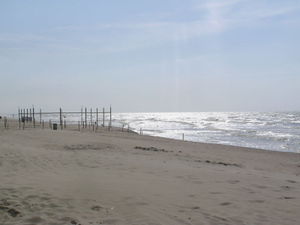Difference between revisions of "Sandy shores"
| Line 5: | Line 5: | ||
Sandy shores or beaches are '''loose deposits of sand''', gravel or shells that cover the shoreline in many places. They make up two-thirds of the world’s ice-free coastlines. Beaches serve as buffer zones or shock absorbers that protect the coastline, sea cliffs or [[Sand Dunes in Europe|dunes]] from direct wave attack. It is an extremely '''dynamic''' environment where sand, water and air are always in motion. Beaches also provide important coastal recreational areas for a many people. Fine-grained sand beaches tend to be '''quite flat'''. | Sandy shores or beaches are '''loose deposits of sand''', gravel or shells that cover the shoreline in many places. They make up two-thirds of the world’s ice-free coastlines. Beaches serve as buffer zones or shock absorbers that protect the coastline, sea cliffs or [[Sand Dunes in Europe|dunes]] from direct wave attack. It is an extremely '''dynamic''' environment where sand, water and air are always in motion. Beaches also provide important coastal recreational areas for a many people. Fine-grained sand beaches tend to be '''quite flat'''. | ||
| + | |||
| + | |||
| + | [[image:Sandy shore.jpg|center|thumb|300px|caption|Sandy beach in Middelkerke - Belgium <ref>http://commons.wikimedia.org/wiki/Image:2005-06-26-Middelkerke-55.jpg</ref>]] | ||
| + | |||
| + | |||
| + | ==Formation== | ||
| + | |||
| + | Sandy beaches are soft shores that are formed by '''deposition''' of '''particles''' that have been carried '''by water currents''' from other areas. The transported material is in part derived from the erosion of shores, but the major part is derived from the land and transported by rivers to the sea. The two main types of beach material are '''quartz''' (=silica) sands of terrestrial origin and '''carbonate''' sands of marine origin. The carbonate sand is weathered from mollusk shells and skeletons of other animals. Other material includes heavy minerals, basalt (=volcanic origin) and feldspar. | ||
| + | |||
| + | |||
Revision as of 10:00, 25 July 2008
This article describes the habitat of the Sandy shores. It is one of the sub-categories within the section dealing with biodiversity of marine habitats and ecosystems.
Introduction
Sandy shores or beaches are loose deposits of sand, gravel or shells that cover the shoreline in many places. They make up two-thirds of the world’s ice-free coastlines. Beaches serve as buffer zones or shock absorbers that protect the coastline, sea cliffs or dunes from direct wave attack. It is an extremely dynamic environment where sand, water and air are always in motion. Beaches also provide important coastal recreational areas for a many people. Fine-grained sand beaches tend to be quite flat.

Formation
Sandy beaches are soft shores that are formed by deposition of particles that have been carried by water currents from other areas. The transported material is in part derived from the erosion of shores, but the major part is derived from the land and transported by rivers to the sea. The two main types of beach material are quartz (=silica) sands of terrestrial origin and carbonate sands of marine origin. The carbonate sand is weathered from mollusk shells and skeletons of other animals. Other material includes heavy minerals, basalt (=volcanic origin) and feldspar.
Please note that others may also have edited the contents of this article.
|